Ginger Simpson's Blog, page 34
June 7, 2016
Just DON'T do it!
There have been a few face-palm moments in the writer's world since I posted last Tuesday. The first moment came when a person posted that she was looking for pirate sites for free books. Ummm...what? More than one person rushed to this poster's defense, saying that they love to read but they don't want to pay for the books, and besides which, authors don't need the money. Because, you know, I guess every author is independently wealthy. Ummmm...WHAT??? And then, the original poster blocked the author, any subsequent attempts to defend authors and their intellectual property and she and her friends ridiculed those authors. The kicker to all of this is the original poster is a professional photographer. Ummmmm...WAIT! WHAT?????? The backlash was so intense against this poster that she pulled everything off her professional page and deleted a lot of what was on her personal page.
Then there was the book reviewer/blogger who decided to defend this woman and all those who steal books, by saying that "Hell, yeah, if I'm offered a free book, I'm going to take it." When another author tried to point out to this stealing and how wrong it is for a book blogger to do that, the blogger turned on that author and threatened her by inferring she could destroy said author's sales/livelihood through her blog. The blogger's FB cover photo was a picture of her flipping a double bird to the world. Yeah...classy doesn't seem to be in that blogger's vocabulary.
Lastly, in an author's only group I belong to, there was a discussion about a supposed Christian historical romance, which was termed "safe and sweet" about a woman who was raped, because her life was ruined went through a mail-order bride service to find a spouse and ended up marrying her rapist. In the 65 or so pages of this complete novella, not only does she immediately forgive him, but they end up happily ever after. ARE YOU FREAKIN' KIDDING ME????? Needless to say, the comments in that author's only group were all negative to that author and her choice of "romance material."
In light of the incredibly light sentence that one Brock Turner received for raping a young woman (and his defense was his victim consented before she passed out), the above mentioned "romance" was made all the more sickening. I for one am very tired of what appears to be a disgusting standard when prosecuting a rape--it seems that the victim always has a past, which is forever in play for the defense, and the perpetrator/abuser has always made a simple mistake and he has a promising future. STOP ATTACKING THE VICTIM! She was raped. She was raped while unconscious. She was raped, and then further victimized by the defense's attempt to make her past relative to her rapist's defense. JUST STOP!
And, that book reviewer--I can just about bet she lost a lot of followers. (Or, I would hope she did.)
To the person who was looking for pirate sites to download stolen books from--I'd wish the fleas of a thousand camels would infest your arm pits--but that's too gentle. I hope you find those pirate sites. I hope every computer virus known to mankind infests your computer. I hope one of those viruses is ransom ware. I hope every single photo you've ever taken ends up stolen by that ransom ware and I pray you can't raise the funds to free YOUR intellectual property.
Then there was the book reviewer/blogger who decided to defend this woman and all those who steal books, by saying that "Hell, yeah, if I'm offered a free book, I'm going to take it." When another author tried to point out to this stealing and how wrong it is for a book blogger to do that, the blogger turned on that author and threatened her by inferring she could destroy said author's sales/livelihood through her blog. The blogger's FB cover photo was a picture of her flipping a double bird to the world. Yeah...classy doesn't seem to be in that blogger's vocabulary.
Lastly, in an author's only group I belong to, there was a discussion about a supposed Christian historical romance, which was termed "safe and sweet" about a woman who was raped, because her life was ruined went through a mail-order bride service to find a spouse and ended up marrying her rapist. In the 65 or so pages of this complete novella, not only does she immediately forgive him, but they end up happily ever after. ARE YOU FREAKIN' KIDDING ME????? Needless to say, the comments in that author's only group were all negative to that author and her choice of "romance material."
In light of the incredibly light sentence that one Brock Turner received for raping a young woman (and his defense was his victim consented before she passed out), the above mentioned "romance" was made all the more sickening. I for one am very tired of what appears to be a disgusting standard when prosecuting a rape--it seems that the victim always has a past, which is forever in play for the defense, and the perpetrator/abuser has always made a simple mistake and he has a promising future. STOP ATTACKING THE VICTIM! She was raped. She was raped while unconscious. She was raped, and then further victimized by the defense's attempt to make her past relative to her rapist's defense. JUST STOP!
And, that book reviewer--I can just about bet she lost a lot of followers. (Or, I would hope she did.)
To the person who was looking for pirate sites to download stolen books from--I'd wish the fleas of a thousand camels would infest your arm pits--but that's too gentle. I hope you find those pirate sites. I hope every computer virus known to mankind infests your computer. I hope one of those viruses is ransom ware. I hope every single photo you've ever taken ends up stolen by that ransom ware and I pray you can't raise the funds to free YOUR intellectual property.
Published on June 07, 2016 07:28
June 2, 2016
Going RVing
For the next two months...my participation is going to be sportadic. Hubby and I are taking up residence in our Minnie Winnie and crossing the US. We'll eventuallly end up at Hot August Nights the first week in August to celebrate our 20th wedding anniversary (we were married there.)
So...here's what we'll be driving...

And here's our living quarters but in different colors and a little bit differently arranged:
I'm sure the Internet service will be sporadic at those KOAs. Have a great summer...I know we will.
I feel free to post this as our house will not be vacant and we aren't taking the dogs. They aren't big, but they sure know how to bark. Kudos to my sister Glynda for fur-baby duty and my other Sister, Gwenn, for knocking the dust off of things while we're gone.
So...here's what we'll be driving...

And here's our living quarters but in different colors and a little bit differently arranged:

I'm sure the Internet service will be sporadic at those KOAs. Have a great summer...I know we will.
I feel free to post this as our house will not be vacant and we aren't taking the dogs. They aren't big, but they sure know how to bark. Kudos to my sister Glynda for fur-baby duty and my other Sister, Gwenn, for knocking the dust off of things while we're gone.
Published on June 02, 2016 23:30
June 1, 2016
The Wild West Meets the Gingerbread Man!
Chances are, if you use the Internet, you have heard about at least one food holiday. You see everyone posting about it on social media, stores advertise special offers and people flip out about whatever particular food is basking in its day the spotlight.
There is no rhyme or reason to the majority of food holidays out there. Most are announced a holiday by the marketing team of a brand, or declared by the popular food day website Foodimentary. There are days that do have a history behind them like National Doughnut Day, which takes place on the first Friday of June. Women volunteering for the Salvation Army would bring doughnuts to the soldiers during World War I to raise their spirits. The day was created by the Salvation Army as a way to raise funds and awareness for the volunteers.
I was delighted to find out that there is a random, fun and quirky food holiday for every day of June. On top of that, they are mostly desserts and we aren't complaining.
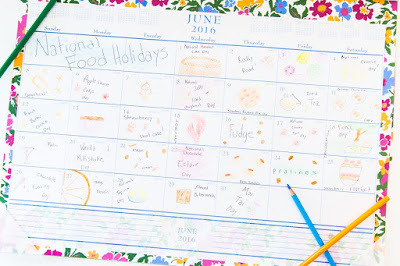
June 1National Hazelnut Cake Day
June 2National Rocky Road Day
June 3National Doughnut Day
June 4National Cheese Day
June 5National Gingerbread Day
National Gingerbread Day! Wow!
Everyone one who knows me or reads my novels, knows I love gingerbread! I bake gingerbread cookies, cakes, trifles, fudge. . .well, you get the idea. I even have my kitchen and dining room (tastefully) decorated in cranberry and cream with gingerbread boys and girls decorating the walls.
When I read that Gingerbread has it's own National 'Food' Day. I began thinking and researching.While we all know about the history of gingerbread in Europe, what do we know about the historyof gingerbread in the Wild West?
Then I located a recipe in an old cookbook.
Old West Cowboy Recipe for: Gingerbread:
Grandma's ginger and spice and everything nice.
- 1-1/2 lbs flour
- 1/2 lb. real butter
- 1/2 lb. brown sugar
- 1/2 pt. molassas
- 2 tbls cream
- 1 tsp baking soda
- ginger (to taste)
Mix all ingredients together. Make in into a stiff paste, and roll it out thin. Put it on buttered tins, and bake in a moderate oven till done, approximately 30-40 minutes.

And from an 1800's Pioneer Cookbook I located another reference to a gingerbread cake.
By-Guess By-Gosh Gingerbread
Pioneer recipes were seldom as specific as recipes today but this one has me puzzled.
She wrote, “I always take some flour, just enough for the size of the cake I want to bake. I mix it up with some buttermilk if I happen to have any around, just enough for the flour. Then I take some ginger; some like more, some like less. I put in a little salt and pearl ash, and then I tell one of my children to pour in molasses until I tell him to stop. Then the children bring in wood to build up a good fire and we have gingerbread for company." No doubt Grandma got better results from this recipe than I would.
While I wasn't able to locate very much information on the subject, I believe it is safe to assume, that gingerbread was consumed and enjoyed in the American West.
Of course, spices were expensive, so these tasty desserts were probably limited to special occasions and, or, holiday celebrations.
Happy June, everyone!
Feel free to indulge in your 'favorite' food during this month.
Connie
There is no rhyme or reason to the majority of food holidays out there. Most are announced a holiday by the marketing team of a brand, or declared by the popular food day website Foodimentary. There are days that do have a history behind them like National Doughnut Day, which takes place on the first Friday of June. Women volunteering for the Salvation Army would bring doughnuts to the soldiers during World War I to raise their spirits. The day was created by the Salvation Army as a way to raise funds and awareness for the volunteers.
I was delighted to find out that there is a random, fun and quirky food holiday for every day of June. On top of that, they are mostly desserts and we aren't complaining.

June 1National Hazelnut Cake Day
June 2National Rocky Road Day
June 3National Doughnut Day
June 4National Cheese Day
June 5National Gingerbread Day
National Gingerbread Day! Wow!
Everyone one who knows me or reads my novels, knows I love gingerbread! I bake gingerbread cookies, cakes, trifles, fudge. . .well, you get the idea. I even have my kitchen and dining room (tastefully) decorated in cranberry and cream with gingerbread boys and girls decorating the walls.

When I read that Gingerbread has it's own National 'Food' Day. I began thinking and researching.While we all know about the history of gingerbread in Europe, what do we know about the historyof gingerbread in the Wild West?
Then I located a recipe in an old cookbook.
Old West Cowboy Recipe for: Gingerbread:
Grandma's ginger and spice and everything nice.
- 1-1/2 lbs flour
- 1/2 lb. real butter
- 1/2 lb. brown sugar
- 1/2 pt. molassas
- 2 tbls cream
- 1 tsp baking soda
- ginger (to taste)
Mix all ingredients together. Make in into a stiff paste, and roll it out thin. Put it on buttered tins, and bake in a moderate oven till done, approximately 30-40 minutes.

And from an 1800's Pioneer Cookbook I located another reference to a gingerbread cake.
By-Guess By-Gosh Gingerbread
Pioneer recipes were seldom as specific as recipes today but this one has me puzzled.
She wrote, “I always take some flour, just enough for the size of the cake I want to bake. I mix it up with some buttermilk if I happen to have any around, just enough for the flour. Then I take some ginger; some like more, some like less. I put in a little salt and pearl ash, and then I tell one of my children to pour in molasses until I tell him to stop. Then the children bring in wood to build up a good fire and we have gingerbread for company." No doubt Grandma got better results from this recipe than I would.
While I wasn't able to locate very much information on the subject, I believe it is safe to assume, that gingerbread was consumed and enjoyed in the American West.
Of course, spices were expensive, so these tasty desserts were probably limited to special occasions and, or, holiday celebrations.
Happy June, everyone!
Feel free to indulge in your 'favorite' food during this month.
Connie
Published on June 01, 2016 22:27
May 31, 2016
Tips by Kristy #writingtips
By Kristy McCaffrey
Writing is an inherently private endeavor, despite any support group an author might have. As such, it can be exceedingly difficult to gain perspective on one’s own work. And while the input of other writer’s opinions should be sought, along with editorial advice, the feedback can sometimes prove to be confusing. As such, we must learn to be our own best guides in our writing life. Reviewing books and judging writing contests can offer a unique avenue to improving your own writing.

For two years I worked on the book review team for Women’s Adventure magazine. Book solicitations were forwarded to us and we were each allowed to choose (or not choose) any of the selections. And while most of the books submitted (via authors, publishers, and publicists) were adventurous memoirs, we also received fiction books and even a few romances. This selection process showed me several things: each reviewer (there were four of us) had her own personal likes and dislikes, the presentation of a review query was so very important (explain your book and why we would want to read it but keep it short, and include relevant links to a website, book page, etc.—don’t make a reviewer hunt for them), and finally there’s an element of serendipity to getting your book read and reviewed.
Some books I requested I dove into and loved immediately. Some books, while well-written, didn’t contain subject matter terribly interesting to me, but by reading a little every day I could reach the end. Then there were other books, ones that I’d requested but once they arrived I couldn’t seem to muster up any enthusiasm to read. There were also a few that, once begun, were badly written. I always gave a book at least three chapters before giving up. But if I couldn’t in good conscience recommend a story, I would pass on the review. Issues with these books ranged from rambling, incoherent chapters with bad transitions to shallow storylines (adventure memoirs require a certain amount of digging deep emotionally) to too much telling and not letting the story simply unfold. Sometimes an author would interject with a 20/20 vision of hindsight from page one and never stop, which can be a huge impediment in narration (and, to be honest, is annoying to read).
Book reviewing helped me understand how my own writing might be lacking in both presentation and depth. It also expanded my reading repertoire and this can have a profound impact on your own writing curiosities.
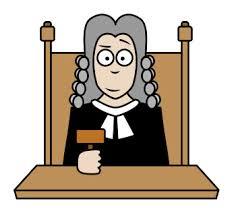
Judging a writing contest is a wonderful way to give back to the community in which you make a living (or hope to). Many authors are asked to judge unpublished writers and I’ve always done my best to offer constructive feedback and not just return a scoresheet with a number on it. But what really opened my eyes about the subjectivity of writing was judging a published writer’s contest. In each instance, I was given polished and excellent works. It was a huge challenge to score such a contest, because there was very little to critique. It really came down to my own attachment to the story and the characters. I really felt bad for the stories that didn’t win because in most instances, they all deserved to win. So, if your books aren’t claiming awards, it may have nothing to do with the quality or your abilities as a writer but everything to do with how your tale connected with the reader/judge.
By reviewing and judging other writers, critical skills can be sharpened, serving as a catalyst to improve writing skills even if one is a seasoned author. It can help you identify what styles and tropes resonate, and which ones don’t. Even better, you’ll understand where your work falls along the writing spectrum.

Writing is an inherently private endeavor, despite any support group an author might have. As such, it can be exceedingly difficult to gain perspective on one’s own work. And while the input of other writer’s opinions should be sought, along with editorial advice, the feedback can sometimes prove to be confusing. As such, we must learn to be our own best guides in our writing life. Reviewing books and judging writing contests can offer a unique avenue to improving your own writing.

For two years I worked on the book review team for Women’s Adventure magazine. Book solicitations were forwarded to us and we were each allowed to choose (or not choose) any of the selections. And while most of the books submitted (via authors, publishers, and publicists) were adventurous memoirs, we also received fiction books and even a few romances. This selection process showed me several things: each reviewer (there were four of us) had her own personal likes and dislikes, the presentation of a review query was so very important (explain your book and why we would want to read it but keep it short, and include relevant links to a website, book page, etc.—don’t make a reviewer hunt for them), and finally there’s an element of serendipity to getting your book read and reviewed.
Some books I requested I dove into and loved immediately. Some books, while well-written, didn’t contain subject matter terribly interesting to me, but by reading a little every day I could reach the end. Then there were other books, ones that I’d requested but once they arrived I couldn’t seem to muster up any enthusiasm to read. There were also a few that, once begun, were badly written. I always gave a book at least three chapters before giving up. But if I couldn’t in good conscience recommend a story, I would pass on the review. Issues with these books ranged from rambling, incoherent chapters with bad transitions to shallow storylines (adventure memoirs require a certain amount of digging deep emotionally) to too much telling and not letting the story simply unfold. Sometimes an author would interject with a 20/20 vision of hindsight from page one and never stop, which can be a huge impediment in narration (and, to be honest, is annoying to read).
Book reviewing helped me understand how my own writing might be lacking in both presentation and depth. It also expanded my reading repertoire and this can have a profound impact on your own writing curiosities.

Judging a writing contest is a wonderful way to give back to the community in which you make a living (or hope to). Many authors are asked to judge unpublished writers and I’ve always done my best to offer constructive feedback and not just return a scoresheet with a number on it. But what really opened my eyes about the subjectivity of writing was judging a published writer’s contest. In each instance, I was given polished and excellent works. It was a huge challenge to score such a contest, because there was very little to critique. It really came down to my own attachment to the story and the characters. I really felt bad for the stories that didn’t win because in most instances, they all deserved to win. So, if your books aren’t claiming awards, it may have nothing to do with the quality or your abilities as a writer but everything to do with how your tale connected with the reader/judge.
By reviewing and judging other writers, critical skills can be sharpened, serving as a catalyst to improve writing skills even if one is a seasoned author. It can help you identify what styles and tropes resonate, and which ones don’t. Even better, you’ll understand where your work falls along the writing spectrum.

Published on May 31, 2016 23:30
May 30, 2016
Frozen Charlotte and king cake
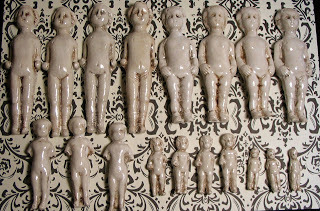 examples of Frozen Charlotte dolls
examples of Frozen Charlotte dollsI can officially confirm—the Internet is a rabbit hole that would terrify even the bravest Alice the world can produce. I started searching for Victorian toys for boys. (The initial search for Victorian boys toys was…creepy.) And, somehow, I ended up on a chase for Frozen Charlotte dolls. (The male counterpart to these dolls was a Frozen Charlie.) These were tiny, immobile porcelain dolls that cost about a single penny, so Victorian families could afford them. They were also called pillar dolls and bathing dolls. The backs of the dolls were unglazed, so they floated in water, making them an ideal toy for bath play. The more elaborate dolls had hair, eye detail, pink lips, and cheek color painted on prior to glazing and were also clothed.
this little one is just creepy
Believed to have their origins in a poem and folk ballad that was first printed in 1843 in The Rover, a Maine newspaper. The poem and ballad can be seen as a cautionary tale of the price of vanity, because in the ballad, young Charlotte is cautioned by her mother to wrap up in a blanket before a cold sleigh ride to a New Year’s Eve ball. Charlotte is more concerned with her party dress being wrinkled. There is some debate if the ballad was based on an actual event. (The poem is printed at the end of this blog post.) There are even some frozen Charlotte dolls which come in a tiny coffin. That's just too creepy for me.
 one of the more elaborate dolls
one of the more elaborate dollsFrozen Charlotte dolls were on the Western frontier, as many have been found in old homestead sites and even more have been passed down through the generations.
Arguably, and based on local lore, there is another place these little dolls continue to appear and that is in the king cakes connected with Mardi Gras. Originally, a single bean was baked into the cake and the person who found the bean in his or her piece of cake became the king or queen of the next ball, creating a series of balls that would culminate with the final grand event on Mardi Gras evening. Over the years, the practice spread beyond Mardi Gras royalty. The person who received the prize — which instead of a bean could be a nut, a coin or even a ring — would be king or queen for the day and in charge of hosting the next party or supplying the next king cake, a tradition that remains today.
However, in the 1940s, McKenzie's Bakery owner Donald Entringer baked and sold king cakes to locals. One day, a traveling salesman visited the baker and had an overabundance of little porcelain dolls he hoped to sell. Entringer bought the dolls to hide in the king cakes and a new tradition was born.
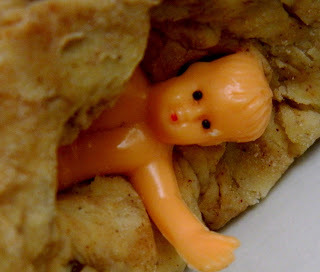 plastic baby getting ready to hide in a king cake prior to baking
plastic baby getting ready to hide in a king cake prior to bakingFor what’s worth, I am the proud owner of a baby from a king cake. That plastic baby has an honored spot in my tack box and so far, it seems to be bringing me pretty good luck this year.
Young Charlotteby Seba Smith
Now, Charlotte lived on the mountainside,In a bleak and dreary spot;There was no house for miles around,Except her father's cot.
And yet on many a wintry night,Young swains were gathered there;For her father kept a social board,And she was very fair.
One New Year's Eve as the sun went down,Far looked her wishful eyeOut from the frosty window paneAs merry sleighs went by.
In a village fifteen miles away,Was to be a ball that night;And though the air was heavy and cold,Her heart was warm and light.
How brightly beamed her laughing eye,As a well-known voice was heard;And driving up to the cottage door,Her lover's sleigh appeared.
"O, daughter dear," her mother cried,"This blanket 'round you fold;It is a dreadful night tonight,You'll catch your death of cold."
"O, nay! O, nay!" young Charlotte cried,And she laughed like a gypsy queen;"To ride in blankets muffled up,I never would be seen.
"My silken cloak is quite enough,You know 'tis lined throughout;Besides I have my silken scarf,To twine my neck about."
Her bonnet and her gloves were on,She stepped into the sleigh;Rode swiftly down the mountain side,And o'er the hills away.
With muffled face and silent lips,Five miles at length were passed;When Charles with few and shivering words,The silence broke at last.
"Such a dreadful night I never saw,The reins I scarce can hold."Fair Charlotte shivering faintly said,"I am exceeding cold."
He cracked his whip, he urged his steedMuch faster than before;And thus five other dreary milesIn silence were passed o'er.
Said Charles, "How fast the shivering iceIs gathering on my brow."And Charlotte still more faintly said,"I'm growing warmer now."
So on they rode through frosty airAnd glittering cold starlight,Until at last the village lampsAnd the ballroom came in sight.
They reached the door and Charles sprang out,He reached his hand for her;She sat there like a monument,That has no power to stir.
He called her once, he called her twice,She answered not a word;He asked her for her hand again,And still she never stirred.
He took her hand in his - O, God!'Twas cold and hard as stone;He tore the mantle from her face,Cold stars upon it shone.
Then quickly to the glowing hall,Her lifeless form he bore;Fair Charlotte's eyes were closed in death,Her voice was heard no more.
And there he sat down by her side,While bitter tears did flow;And cried, "My own, my charming bride,You never more will know."
He twined his arms around her neck,He kissed her marble brow;His thoughts flew back to where she said,"I'm growing warmer now."
He carried her back to the sleigh,And with her he rode home;And when he reached the cottage door,O, how her parents mourned.
Her parents mourned for many a year,And Charles wept in the gloom;Till at last her lover died of grief,And they both lie in one tomb.
Published on May 30, 2016 22:00
May 24, 2016
What Does Shanna Hatfield Like to Do?
Perhaps I shouldn't love it as much as I do, but there are few things I enjoy as much as attending a good rodeo.
A few weeks ago, Captain Cavedweller and I spent a few days in Pendleton, Oregon, attending the world famous Pendleton Round-Up. The first Pendleton Round-Up was held in the early 1900s and has a long, rich history.
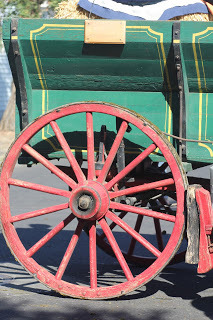 One of the great things about going to the Round-Up is the Westward Ho Parade. There isn't a single motorized vehicle in the parade, but there are oodles of horses and vintage conveyances.
One of the great things about going to the Round-Up is the Westward Ho Parade. There isn't a single motorized vehicle in the parade, but there are oodles of horses and vintage conveyances.I snap bunches of photos so I can pull them up and study the details when I'm working on a story.
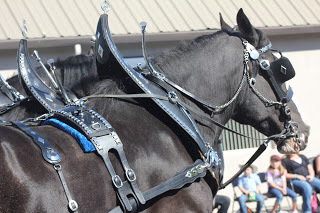 It's not every day you have the opportunity to see horses and mules in harnesses (especially spit and polished for a parade).
It's not every day you have the opportunity to see horses and mules in harnesses (especially spit and polished for a parade).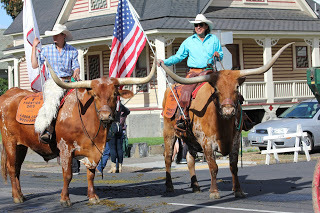 And you definitely don't see this everyday. These two characters were one of the most talked about entries in the parade. Later, they hung out in the park and let people take photos on the backs of the these tame giants.
And you definitely don't see this everyday. These two characters were one of the most talked about entries in the parade. Later, they hung out in the park and let people take photos on the backs of the these tame giants.Of course, one of the other things I love about the experience, is the rodeo. Since I write a lot about cowboys in general and rodeos in particular, it provides an opportunity for me to capture hundreds of images I can later use for research purposes.
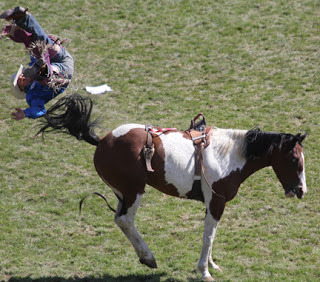
(And for fun!)
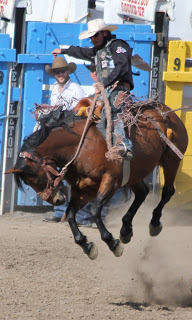
Even if this is at a modern-day rodeo, I could easily use this photo to describe a scene of someone riding a bronc in any time frame.
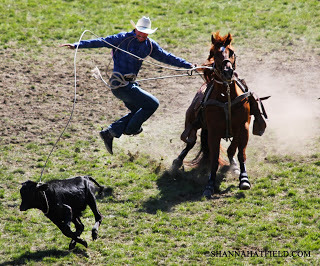 This was my favorite photo of all those I took. This cowboy almost looks like he's performing some intricately choreographed dance move.
This was my favorite photo of all those I took. This cowboy almost looks like he's performing some intricately choreographed dance move.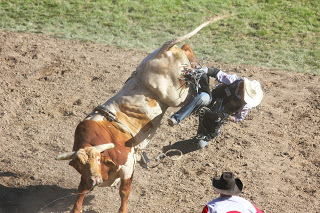 And you gotta have a photo of bull riding, even if this ol' boy was a little snotty.
And you gotta have a photo of bull riding, even if this ol' boy was a little snotty. ~*~*~
 A hopeless romantic with a bit of sarcasm thrown in for good measure, Shanna Hatfield is a bestselling author of sweet romantic fiction written with a healthy dose of humor. In addition to blogging and eating too much chocolate, she is completely smitten with her husband, lovingly known as Captain Cavedweller.
A hopeless romantic with a bit of sarcasm thrown in for good measure, Shanna Hatfield is a bestselling author of sweet romantic fiction written with a healthy dose of humor. In addition to blogging and eating too much chocolate, she is completely smitten with her husband, lovingly known as Captain Cavedweller.Shanna creates character-driven romances with realistic heroes and heroines. Her historical westerns have been described as “reminiscent of the era captured by Bonanza and The Virginian” while her contemporary works have been called “laugh-out-loud funny, and a little heart-pumping sexy without being explicit in any way.”
She is a member of Western Writers of America, Women Writing the West, and Romance Writers of America.
Find Shanna’s books at:
Amazon | Amazon UK | Barnes & Noble | Smashwords | Apple
Shanna loves to hear from readers! Follow her online:
ShannaHatfield | Facebook | Pinterest | Goodreads | You Tube | Twitter
Published on May 24, 2016 23:30
May 23, 2016
What the h&$#?????
I just had a heart-attack. Okay, not really, but it certainly felt like I did when I clicked on the icon for Microsoft Word and got an error message that said Office wasn’t available on my computer.
SAY WHAT???
Moment of utter panic, heart pounding its way right into the back of my throat…and then like any one with a lick of common sense would do, I cussed out the computer. Oh, that’s not really common sense, is it? After I called my poor lap top everything but an artificial intelligence, I shut it down, rebooted, and voila! There was Word again, and all the other Office programs.
The whole time the computer was shutting down and the rebooting, I was whispering a mantra of “Be there. You have to be there. Where could you have gone?”
Sometimes, I hate Microsoft. Other times, I really, really hate Microsoft. This was one of those really, really hate moments. But, it’s all good now. I’m able to write this blog post, I’ll get it scheduled to go live, and then I can go back to writing my latest WIP.
Stop freaking me out, Microsoft!
SAY WHAT???
Moment of utter panic, heart pounding its way right into the back of my throat…and then like any one with a lick of common sense would do, I cussed out the computer. Oh, that’s not really common sense, is it? After I called my poor lap top everything but an artificial intelligence, I shut it down, rebooted, and voila! There was Word again, and all the other Office programs.
The whole time the computer was shutting down and the rebooting, I was whispering a mantra of “Be there. You have to be there. Where could you have gone?”
Sometimes, I hate Microsoft. Other times, I really, really hate Microsoft. This was one of those really, really hate moments. But, it’s all good now. I’m able to write this blog post, I’ll get it scheduled to go live, and then I can go back to writing my latest WIP.
Stop freaking me out, Microsoft!
Published on May 23, 2016 22:00
May 19, 2016
Ladies of the Evening in the Old West

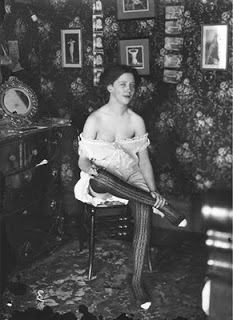 The subject of prostitution in the Old West produces a lively conversation that can be intriguing as well as educational. However gritty and dangerous prostitution was, the act was often viewed as a healthy and integral part of life. As more and more male settlers, prospectors, cowboys and speculators ventured West, the need for female companionship ballooned. In lonely mining camps, men sometimes paid just to view female garments, on or off the woman. Many of the few but brave, or perhaps desperate, women who made their way from the East looked for riches in the skin trade. Almost every mining camp, boomtown and whistle-stop housed at least one or two soiled doves, if not an entire, roaring red-light district. This contributed greatly to town economies via business licenses, fees, and fines. The financial welfare of prostitutes depended on where they worked. Those living above bars or in seedy brothels rarely made enough money to retire and often ended their lives by suicide, overdoses or illness. Gonorrhea, syphilis, and Chlamydia, potentially fatal maladies, ran rampant during in the 1800s. According to reports from an Idaho hospital, one out of every seven patients suffered from venereal disease. Botched abortions and murder rounded out the number of women who died working as soiled doves. Madams, who had more control over their businesses,fared better, but not by much. On the other hand, Mattie Silks of Denver once netted $38,000 running a bordello for three months in Dawson City, Alaska. But when she died in 1929, her assets amounted to no more than a few thousand dollars.
The subject of prostitution in the Old West produces a lively conversation that can be intriguing as well as educational. However gritty and dangerous prostitution was, the act was often viewed as a healthy and integral part of life. As more and more male settlers, prospectors, cowboys and speculators ventured West, the need for female companionship ballooned. In lonely mining camps, men sometimes paid just to view female garments, on or off the woman. Many of the few but brave, or perhaps desperate, women who made their way from the East looked for riches in the skin trade. Almost every mining camp, boomtown and whistle-stop housed at least one or two soiled doves, if not an entire, roaring red-light district. This contributed greatly to town economies via business licenses, fees, and fines. The financial welfare of prostitutes depended on where they worked. Those living above bars or in seedy brothels rarely made enough money to retire and often ended their lives by suicide, overdoses or illness. Gonorrhea, syphilis, and Chlamydia, potentially fatal maladies, ran rampant during in the 1800s. According to reports from an Idaho hospital, one out of every seven patients suffered from venereal disease. Botched abortions and murder rounded out the number of women who died working as soiled doves. Madams, who had more control over their businesses,fared better, but not by much. On the other hand, Mattie Silks of Denver once netted $38,000 running a bordello for three months in Dawson City, Alaska. But when she died in 1929, her assets amounted to no more than a few thousand dollars.
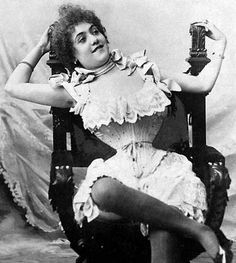
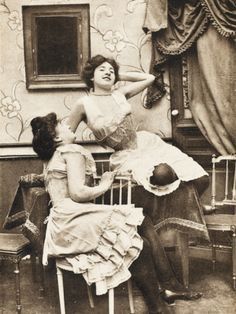 Despite their black reputations, some whores proved to be, indeed, fallen angels. During her years as a madam, Laura Evens of Salida, Colorado, sheltered abused wives and secretly paid the wages of men recovering from injuries on the job. Still, these women suffered blatant hypocrisy at the hands of local government.
Despite their black reputations, some whores proved to be, indeed, fallen angels. During her years as a madam, Laura Evens of Salida, Colorado, sheltered abused wives and secretly paid the wages of men recovering from injuries on the job. Still, these women suffered blatant hypocrisy at the hands of local government.
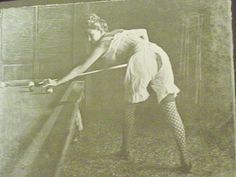 Towns demanded red light ladies pay monthly fines, fees, and taxes, even as authorities staged raids and arrests. In 1908, officials in Salt Lake City, Utah, hired Dora Topham, the leading madam of Ogden to operate a “legal” red-light district. Appealed with the idea, Topham oversaw construction of the “Stockade,” a high-walled city block housing several cribs, six parlor homes, a dance hall, saloons, a cigar store and a small jail cell. Up to 150 women could work the Stockade at a time. The project failed for several reasons; the lack of cooperation from local prostitutes unwilling to sell out and move to the Stockade; employees who felt stifled by the stringent regulations; and customers hesitant to be seen entering the premises. Plus, the government continued to stage raids to appease county, state and federal laws. In 1911, Topham was accused of working as a madam by the same officials who hired her to do so.
Towns demanded red light ladies pay monthly fines, fees, and taxes, even as authorities staged raids and arrests. In 1908, officials in Salt Lake City, Utah, hired Dora Topham, the leading madam of Ogden to operate a “legal” red-light district. Appealed with the idea, Topham oversaw construction of the “Stockade,” a high-walled city block housing several cribs, six parlor homes, a dance hall, saloons, a cigar store and a small jail cell. Up to 150 women could work the Stockade at a time. The project failed for several reasons; the lack of cooperation from local prostitutes unwilling to sell out and move to the Stockade; employees who felt stifled by the stringent regulations; and customers hesitant to be seen entering the premises. Plus, the government continued to stage raids to appease county, state and federal laws. In 1911, Topham was accused of working as a madam by the same officials who hired her to do so.
Prices for services: By a Chinese, black or American Indian girl, in Tombstone, Arizona, circa 1880 - $.25 By a Mexican prostitute in Tombstone, same era - $.50 By a French girl in Tombstone, same era - $.75 Service to soldiers at Fort Whipple, Arizona - $1 Visit to plush parlor house in Tombstone, same era - $10 Service lasting an entire night in a Tombstone bordello - $30 Number of customers some women saw in an average payday at the mines – 70 Weekly salary of a prostitute in Tombstone during the 1800s - $150 All night stay at Old Homestead in Cripple Creek, Colorado in 1890s - $250 Estate of Madam Mary “Mother Gleim” of Missoula, Montana at time of her death in 1914 - $148,000 To read more about soiled doves in the Old West, check out Amazon.com
Charlene Raddon is an award-winning, multi-published author of historical romance set in the American West. She is also a cover artist.You can find her at:
http://charleneraddon.com.
http://facebook.com/charleneraddon
http://twitter.com/craddon
Published on May 19, 2016 23:30
May 18, 2016
Mail-Order Brides in the Wild West By Connie Vines
MAIL-ORDER BRIDES in the Wild West.
We have all watched many a western movie featuring Mail-Order Brides. I also recall a musical
(Seven Brides for Seven Brothers) on stage before becoming a 1950's movie also.
So how historically accurate were these movies and (Here Come The Brides) television shows?
What was I able to uncover during my research?
The term "mail-order bride," as it applies to a marriage arranged via correspondence between American men and women in the Great Plains in the nineteenth century, is largely a misnomer. Twentieth-century folklore has it that a homesteader could peruse the Sears and Roebuck or Montgomery Ward catalogs and order a wife to be delivered to his dusty doorstep just as easily as he could order a rifle, stove, or stomach cure, but the truth is far more interesting.
Arranged long-distance marriage existed in the Plains in a range of communities, took a number of forms, and grew out of a variety of social, economic, and cultural phenomena, but never involved the literal sale, purchase, or ownership of women, as the term "mail-order bride" suggests. (Thank goodness!)
Among Plains Indians, sight-unseen marriage was frequently arranged with the help of a middleman and could involve the payment of a "bride price," intended to compensate the woman's family for the impending loss of her labor. But intercultural marriage was rare. In 1854, at a peace conference at Fort Laramie, a prominent Cheyenne chief requested of the U.S. Army the gift of 100 white women as brides, but the army refused. Russian immigrants brought with them the tradition of koopla, whereby marriage brokers were paid a fee to pair men with potential spouses from the Old Country.
During the peak years of overland migration, hundreds of thousands of white women traveled west, but the majority were already married, and it was thought that "suitable" single women did not go west alone. While many cowboys eschewed marriage for perpetual bachelorhood, homesteaders believed that married men made better farmers.
From the 1830s until the turn of the twentieth century, settlers pined for "that useful and essential article of household furniture–a wife." So severe was the shortage of single white women of marriageable age in Nebraska, recounts Mari Sandoz in Old Jules (1935), her classic portrait of Plains homesteading, "a man had to marry anything that got off the train."
By 1865 it was estimated that there were as many as 30,000 single women back east, a number augmented by the Civil War widows. The plenitude of bachelors in the Plains–and hence the chance for greater social and economic freedom away from home–beckoned women. Newspapers from Nebraska to Kansas and Wyoming (a state the Ladies Home Journal in 1899 declared a heaven for spinsters and widows) began to serve as forums for matchmaking, running regular "matrimonial columns" of paid advertisements, frequently with accompanying photographs, for example: "A young lady residing in one of the small towns in Central New York is desirous of opening a correspondence with some young man in the West, with a view to a matrimonial engagement. . . . she is about 24 years of age, possesses a good moral character . . . is tolerably well-educated, and thoroughly versed in the mysteries of housekeeping"; or more commonly, "A Bachelor of 40, good appearance and substantial means, wants a wife. She must be under 30, amiable, and musical." Across the Plains there arose a cottage industry of "heart and hand" catalogs, folded double sheets and broadsides devoted entirely to the matrimonial prospects.
Letters were the only means of courtship between potential mates separated by thousands of miles. According to one bride, the Pony Express "took about four weeks to go from east to west," and letters "often came in bundles." Language was a means of persuasion. Illiterate men could dictate their letters to typists who, for a fee, would doctor their sentiments on Remington Standards. Dishonesty was a risk. Men and women could easily misrepresent their physical attributes, their station, or finances. A homesteader who sent his betrothed a train ticket might find that she had turned it in for cash. A 1911 Wahpeton Times article tells of a New York girl for whom, upon arrival in Buford, North Dakota, "the spell was immediately broken" when she saw the face of her intended. ((Not unlike the social media matches of today's cyber world of romance.)
The railroad also played an important role in the western diaspora of single women. In 1882 businessman Fred Harvey sought young rural women "of good character, attractive and intelligent" as waitresses in whistlestop cafés along the Santa Fe rail line. Harvey required that they remain single for a year, live in chaperoned dormitories, and entertain callers in "courting parlors." By the turn of the century, he had married off nearly 5,000 so-called Harvey Girls.
In the 1870s, 80s and 90’S, Matrimonial News, a San Francisco based matchmaking newspaper helped to make love connections between the single men of the West and the statistically disadvantaged, single women back East. For $1.50 a word, people could place classified ads describing themselves and what they wanted in a potential mate. The paper’s goal was to “promote honorable matrimonial engagements and true conjugal felicities for amiable men and women.” If a match resulted in a wedding, both parties were required to pay an additional fee to the newspaper.
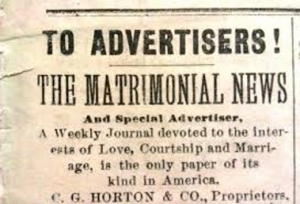
Most ads were fairly direct. I haven’t seen a single ad that mentioned enjoying long walks on the beach, but plenty of them were quite open about wanting someone who wasn’t ugly and had a specified amount of money. (At $1.50 a word, it’s a wonder that some ads didn’t read, “Me want woman!”) Interested parties would correspond with each other and often not meet until they were about to head to the altar. It was quite the leap of faith.
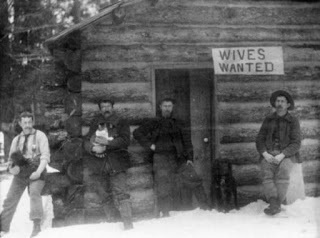
I have a feeling "Seven Brides for Seven Brothers" was not historically accurate--though a great deal of fun!
What would drive a woman to accept such a proposal? What recourse did she have if she changed her mind?
If you have any 'family stores', please share in the comments section of this blog.
Happy Reading,
Connie
For additional information:
Luchetti, Cathy. "I Do!": Courtship, Love, and Marriage on the American Frontier: A Glimpse at America's Romantic Past through Photographs, Diaries, and Journals, 1715–1915. New York: Crown Trade Paperbacks, 1996.
Riley, Glenda. Building and Breaking Families in the American West. Albuquerque: University of New Mexico Press, 1996.
We have all watched many a western movie featuring Mail-Order Brides. I also recall a musical
(Seven Brides for Seven Brothers) on stage before becoming a 1950's movie also.
So how historically accurate were these movies and (Here Come The Brides) television shows?
What was I able to uncover during my research?
The term "mail-order bride," as it applies to a marriage arranged via correspondence between American men and women in the Great Plains in the nineteenth century, is largely a misnomer. Twentieth-century folklore has it that a homesteader could peruse the Sears and Roebuck or Montgomery Ward catalogs and order a wife to be delivered to his dusty doorstep just as easily as he could order a rifle, stove, or stomach cure, but the truth is far more interesting.
Arranged long-distance marriage existed in the Plains in a range of communities, took a number of forms, and grew out of a variety of social, economic, and cultural phenomena, but never involved the literal sale, purchase, or ownership of women, as the term "mail-order bride" suggests. (Thank goodness!)
Among Plains Indians, sight-unseen marriage was frequently arranged with the help of a middleman and could involve the payment of a "bride price," intended to compensate the woman's family for the impending loss of her labor. But intercultural marriage was rare. In 1854, at a peace conference at Fort Laramie, a prominent Cheyenne chief requested of the U.S. Army the gift of 100 white women as brides, but the army refused. Russian immigrants brought with them the tradition of koopla, whereby marriage brokers were paid a fee to pair men with potential spouses from the Old Country.
During the peak years of overland migration, hundreds of thousands of white women traveled west, but the majority were already married, and it was thought that "suitable" single women did not go west alone. While many cowboys eschewed marriage for perpetual bachelorhood, homesteaders believed that married men made better farmers.
From the 1830s until the turn of the twentieth century, settlers pined for "that useful and essential article of household furniture–a wife." So severe was the shortage of single white women of marriageable age in Nebraska, recounts Mari Sandoz in Old Jules (1935), her classic portrait of Plains homesteading, "a man had to marry anything that got off the train."
By 1865 it was estimated that there were as many as 30,000 single women back east, a number augmented by the Civil War widows. The plenitude of bachelors in the Plains–and hence the chance for greater social and economic freedom away from home–beckoned women. Newspapers from Nebraska to Kansas and Wyoming (a state the Ladies Home Journal in 1899 declared a heaven for spinsters and widows) began to serve as forums for matchmaking, running regular "matrimonial columns" of paid advertisements, frequently with accompanying photographs, for example: "A young lady residing in one of the small towns in Central New York is desirous of opening a correspondence with some young man in the West, with a view to a matrimonial engagement. . . . she is about 24 years of age, possesses a good moral character . . . is tolerably well-educated, and thoroughly versed in the mysteries of housekeeping"; or more commonly, "A Bachelor of 40, good appearance and substantial means, wants a wife. She must be under 30, amiable, and musical." Across the Plains there arose a cottage industry of "heart and hand" catalogs, folded double sheets and broadsides devoted entirely to the matrimonial prospects.
Letters were the only means of courtship between potential mates separated by thousands of miles. According to one bride, the Pony Express "took about four weeks to go from east to west," and letters "often came in bundles." Language was a means of persuasion. Illiterate men could dictate their letters to typists who, for a fee, would doctor their sentiments on Remington Standards. Dishonesty was a risk. Men and women could easily misrepresent their physical attributes, their station, or finances. A homesteader who sent his betrothed a train ticket might find that she had turned it in for cash. A 1911 Wahpeton Times article tells of a New York girl for whom, upon arrival in Buford, North Dakota, "the spell was immediately broken" when she saw the face of her intended. ((Not unlike the social media matches of today's cyber world of romance.)
The railroad also played an important role in the western diaspora of single women. In 1882 businessman Fred Harvey sought young rural women "of good character, attractive and intelligent" as waitresses in whistlestop cafés along the Santa Fe rail line. Harvey required that they remain single for a year, live in chaperoned dormitories, and entertain callers in "courting parlors." By the turn of the century, he had married off nearly 5,000 so-called Harvey Girls.
In the 1870s, 80s and 90’S, Matrimonial News, a San Francisco based matchmaking newspaper helped to make love connections between the single men of the West and the statistically disadvantaged, single women back East. For $1.50 a word, people could place classified ads describing themselves and what they wanted in a potential mate. The paper’s goal was to “promote honorable matrimonial engagements and true conjugal felicities for amiable men and women.” If a match resulted in a wedding, both parties were required to pay an additional fee to the newspaper.

Most ads were fairly direct. I haven’t seen a single ad that mentioned enjoying long walks on the beach, but plenty of them were quite open about wanting someone who wasn’t ugly and had a specified amount of money. (At $1.50 a word, it’s a wonder that some ads didn’t read, “Me want woman!”) Interested parties would correspond with each other and often not meet until they were about to head to the altar. It was quite the leap of faith.

I have a feeling "Seven Brides for Seven Brothers" was not historically accurate--though a great deal of fun!
What would drive a woman to accept such a proposal? What recourse did she have if she changed her mind?
If you have any 'family stores', please share in the comments section of this blog.
Happy Reading,
Connie
For additional information:
Luchetti, Cathy. "I Do!": Courtship, Love, and Marriage on the American Frontier: A Glimpse at America's Romantic Past through Photographs, Diaries, and Journals, 1715–1915. New York: Crown Trade Paperbacks, 1996.
Riley, Glenda. Building and Breaking Families in the American West. Albuquerque: University of New Mexico Press, 1996.
Published on May 18, 2016 22:03
May 17, 2016
Say Hello to Kristy McCaffrey
I'm so excited to share a BRAND NEW, never-before-published short novella ~ The Crow and the Bear. If you read The Crow and the Coyote, a spooky Old West romance that was released last Halloween (in the Cowboys, Creatures and Calico Vol. 2 anthology and more recently as a single sell), then you might remember that hero Jack Boggs had two brothers, Callum and Kit. This tale features Cal. I'm still brewing a story for Kit.
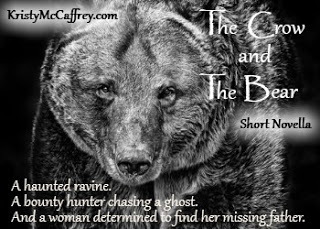
The idea for The Crow and the Bear came to me during the summer when my family and I visited Silverton, Colorado, an old mining town situated in an imposing valley of the Rocky Mountains. While touring the local museum I became fascinated by the Tommyknockers.
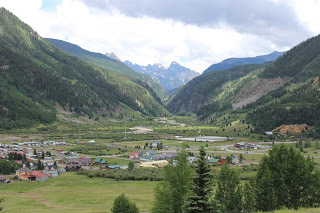 Silverton, ColoradoA Tommyknocker is a type of troll spirit who lives underground and was therefore of great concern to miners. The term originated in the British Isles, but superstitions surrounding the beings filtered into other places. Miners in Colorado took great care to appease the Knockers by leaving a bit of their lunch out for the sprites.
Silverton, ColoradoA Tommyknocker is a type of troll spirit who lives underground and was therefore of great concern to miners. The term originated in the British Isles, but superstitions surrounding the beings filtered into other places. Miners in Colorado took great care to appease the Knockers by leaving a bit of their lunch out for the sprites.

Standing about two feet tall with a grizzled appearance, many believe that Snow White’s dwarves were Tommyknockers. They usually wear standard miner’s garb and are responsible for any mischief that might befall a miner, such as losing tools and food.
The name derives from the knocking on mine walls that precedes a cave-in, which is usually just the creaking of earth and timbers before failing. Some miners believed the Knockers were malevolent beings, but others took them to be practical jokers.
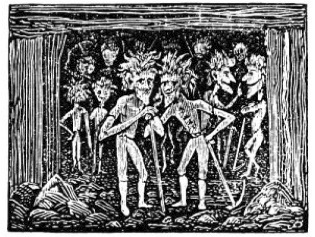
In Cornish folklore, the Knockers were spirits of those who had died in previous mine accidents and were now trying to help the living, by warning of impending dangers. As an offering of thanks, miners usually cast the last bite of their lunch pastie (a type of meat pie) into the mines for the Knockers.
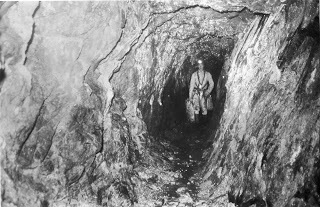
In the 1820’s, Welsh immigrants to Pennsylvania brought tales of the Knockers with them and their presence soon spread all the way to California. Belief in the Knockers remained well into the 20th century. During the closing of a mine in 1956, a petition was circulated by the miners to set the Knockers free (so they could move to another mine) before sealing the entrances, and the owners complied.

The Crow Series: Book 2Short NovellaBounty hunter Callum Boggs—sometimes called Crow—arrives in the mining town of Silverton on a cold October day in search of a man who has committed unspeakable crimes. Skilled in the technique of dream scouting, Crow has narrowed the location of the criminal to Silas Ravine. No normal man would dare to venture into this region, where so many gruesome and unexplained murders have taken place—a piece of land forever haunted where Death still walks. But Crow is no normal man...
Jennie Livingstone knows her papa is in trouble. When none of the local men will come to her aid, she must accept a newly-arrived stranger—a half-Comanche bounty hunter—as her only ally. As they head into the mountains to track Jennie’s father, she can hear more than the whispers of man. The mines carry spirits, and her only hope in navigating the living and the dead lies with the Crow.
But is Jennie prepared for the consequences of where her fate with Callum Boggs may lead? And is she the woman who can hold fast to the Crow’s heart after all his years alone? Bewitched by the beautiful young woman, Callum must do everything he can to stay one step ahead of the spirits that can’t rest—just to keep Jennie and himself alive.
Amazon | iBooks | Nook | Smashwords
Don't miss the first one!!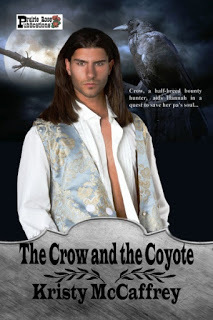
The Crow Series: Book 1Short NovellaIn Arizona Territory, Hannah Dobbin travels through Cañon de Chelly, home to the Navajo, in search of a sorcerer who murdered her pa. Only when she retrieves the silver cross taken from her father's corpse will she be able to free her pa's spirit, and allow him to be at peace.
Bounty Hunter Jack Boggs—known as Crow—is on the trail of a vile Mexican bandito when he discovers Hannah and her companion, a superstitious old Navajo woman. He knows he must protect them, but with the shadows of Hallowtide descending, more dark magic is at hand than any of them know.
Amazon | iBooks | Nook | Kobo | Smashwords

Website | Facebook | Twitter

The idea for The Crow and the Bear came to me during the summer when my family and I visited Silverton, Colorado, an old mining town situated in an imposing valley of the Rocky Mountains. While touring the local museum I became fascinated by the Tommyknockers.
 Silverton, ColoradoA Tommyknocker is a type of troll spirit who lives underground and was therefore of great concern to miners. The term originated in the British Isles, but superstitions surrounding the beings filtered into other places. Miners in Colorado took great care to appease the Knockers by leaving a bit of their lunch out for the sprites.
Silverton, ColoradoA Tommyknocker is a type of troll spirit who lives underground and was therefore of great concern to miners. The term originated in the British Isles, but superstitions surrounding the beings filtered into other places. Miners in Colorado took great care to appease the Knockers by leaving a bit of their lunch out for the sprites.
Standing about two feet tall with a grizzled appearance, many believe that Snow White’s dwarves were Tommyknockers. They usually wear standard miner’s garb and are responsible for any mischief that might befall a miner, such as losing tools and food.
The name derives from the knocking on mine walls that precedes a cave-in, which is usually just the creaking of earth and timbers before failing. Some miners believed the Knockers were malevolent beings, but others took them to be practical jokers.

In Cornish folklore, the Knockers were spirits of those who had died in previous mine accidents and were now trying to help the living, by warning of impending dangers. As an offering of thanks, miners usually cast the last bite of their lunch pastie (a type of meat pie) into the mines for the Knockers.

In the 1820’s, Welsh immigrants to Pennsylvania brought tales of the Knockers with them and their presence soon spread all the way to California. Belief in the Knockers remained well into the 20th century. During the closing of a mine in 1956, a petition was circulated by the miners to set the Knockers free (so they could move to another mine) before sealing the entrances, and the owners complied.

The Crow Series: Book 2Short NovellaBounty hunter Callum Boggs—sometimes called Crow—arrives in the mining town of Silverton on a cold October day in search of a man who has committed unspeakable crimes. Skilled in the technique of dream scouting, Crow has narrowed the location of the criminal to Silas Ravine. No normal man would dare to venture into this region, where so many gruesome and unexplained murders have taken place—a piece of land forever haunted where Death still walks. But Crow is no normal man...
Jennie Livingstone knows her papa is in trouble. When none of the local men will come to her aid, she must accept a newly-arrived stranger—a half-Comanche bounty hunter—as her only ally. As they head into the mountains to track Jennie’s father, she can hear more than the whispers of man. The mines carry spirits, and her only hope in navigating the living and the dead lies with the Crow.
But is Jennie prepared for the consequences of where her fate with Callum Boggs may lead? And is she the woman who can hold fast to the Crow’s heart after all his years alone? Bewitched by the beautiful young woman, Callum must do everything he can to stay one step ahead of the spirits that can’t rest—just to keep Jennie and himself alive.
Amazon | iBooks | Nook | Smashwords
Don't miss the first one!!

The Crow Series: Book 1Short NovellaIn Arizona Territory, Hannah Dobbin travels through Cañon de Chelly, home to the Navajo, in search of a sorcerer who murdered her pa. Only when she retrieves the silver cross taken from her father's corpse will she be able to free her pa's spirit, and allow him to be at peace.
Bounty Hunter Jack Boggs—known as Crow—is on the trail of a vile Mexican bandito when he discovers Hannah and her companion, a superstitious old Navajo woman. He knows he must protect them, but with the shadows of Hallowtide descending, more dark magic is at hand than any of them know.
Amazon | iBooks | Nook | Kobo | Smashwords

Website | Facebook | Twitter
Published on May 17, 2016 23:30



